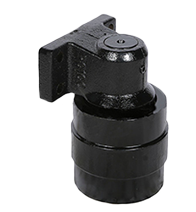Regular hydraulic cylinder maintenance is critical to system maintenance and performance
Here, we share top tips for successful hydraulic cylinder maintenance.
1. First things first - keep hydraulic fluid clean
Many hydraulic failures occur due to hydraulic oil contamination. This is important to prevent damage to the system and components. If the hydraulic fluid is contaminated, it must be cleaned thoroughly as soon as any contamination is detected. It is also best to install a high-efficiency filter and replace it if necessary.
If debris builds up on the filter, a differential pressure gauge can be installed to give you a good indication when the filter needs to be replaced. This means you'll prevent bypasses, where oil flows through the system unfiltered.
2. Perform regular maintenance
Regular maintenance of hydraulic cylinders is very important for optimum performance. Make sure to pay close attention to the condition of the cylinder rod for any signs of corrosion, pitting or wear. Excess moisture can cause corrosion; either from the air or from the hydraulic fluid itself. Water contamination在流体中 can cause major component or system failure - so the oil needs to be thoroughly cleaned as soon as possible. Corrosion can also cause seal wear due to increased friction; pitting corrosion can cause similar problems.
Misalignment is often the main cause of uneven wear within the cylinder. Premature wear of the bearing seals and rod can be caused by side loads causing the rod to rub against one side of the bearing. Cylinder maintenance here can often be as simple as re-chroming or polishing to repair corroded or damaged rods. If the cylinder rod cannot be repaired, replacement is the best course of action. However, before reinstalling a new rod, it is important to first fix the problem that caused the damage in the first place and make the new cylinder more cost-effective.
3. Rotating or Alternating Cylinders
As with other hydraulic components, if the risk of downtime cannot be avoided, then it is best to keep another cylinder as a "critical backup" (see below), or you can alternate it periodically. This break between uses keeps the cylinder in good condition despite possible particulate contamination and harsh operating conditions. It is also wise to perform maintenance on these cylinders when they are taken out of the system so that repairs can be made if necessary.
You may need to replace all seals before reassembling the cylinder. Checking the cylinders can also give you an idea of the condition of the overall system. For example, if you have a consistent varnish in your system, it probably means the oil is overheating and needs to be changed.
4. Maintain your cylinder accessories
Each individual component that makes up a hydraulic cylinder is just as important as the cylinder itself. For example, if the pivot pin or clevis is worn or damaged, this can cause tilt and play in the cylinder joint. This can lead to misalignment and wear or more permanent damage.
*Critical Spare Parts Analysis - Analysis of critical hydraulic components of the system and recommended spare parts; so you can understand which hydraulic components are most prone to failure and the impact this may have on safety, production and system performance...and the implications of sourcing alternatives cost and delivery time.
Hydraulic cylinder test
Hydraulic cylinder testing is critical to maintaining peak performance.
During the test, any leakage needs to be measured, typically by pressurizing the cylinder at the end of the stroke. This hydraulic cylinder testing technique is known as "end-of-stroke bypass testing".
The only major downside to this test is that, as the name suggests, the only seals tested are those at the ends of the cylinder - there is not much degradation of the components there. In fact, the center of the tube is most likely to suffer more damage, so that's where the testing needs to be done.
In double-acting cylinders , the Mid-Stroke Bypass Test is a suitable method for testing piston seals. One of the problems with this technique is how to control the cylinder; a hydraulic engineer must mechanically fix the assembly to keep the cylinder centered. Even smaller sized cylinders can generate 6 to 10 tons of force, so this method is very dangerous. With larger cylinders, this task is impossible.
The only test that works for this is called a "hydrostatic test". This is a test performed after the piston is held hydraulically in any desired position. The resulting pressure build-up helps hold the piston in one position across the cylinder to ensure all seals are functioning and there are no leaks. The only consequence this could have is that if pressure was allowed to build up at the piston end of the cylinder with the valve closed, the rod end would become overstressed, which could lead to catastrophic failure.
In this case, a pressure relief valve must be used at the rod end when hydrostatically tested. This is critical not only for the protection of the machines but also for the personal safety of the engineers conducting the tests. To perform this hydraulic cylinder test, the following steps must be performed:
1.Make sure the cylinder is secured so it can be controlled;
2.Clean hydraulic oil must be filled on both sides of the cylinder - through the service port;
3.Connect all components - directional control valves, safety valves, ball valves and pressure gauges;
4.Use the directional control valve and tap the cylinder several times to expel any air in the cylinder;
5.Put the piston rod in the middle stroke and close the ball valve;
6.Direct fluid to the side of the cylinder where the piston rod is located;
7.Increase the setting of the safety valve until the pressure of the cylinder is seen on the pressure gauge;
8.Close ball valve and directional control valve;
9.Record the cylinder pressure on both gauges and note any changes.

Sign up to our newsletter for the construction machinery